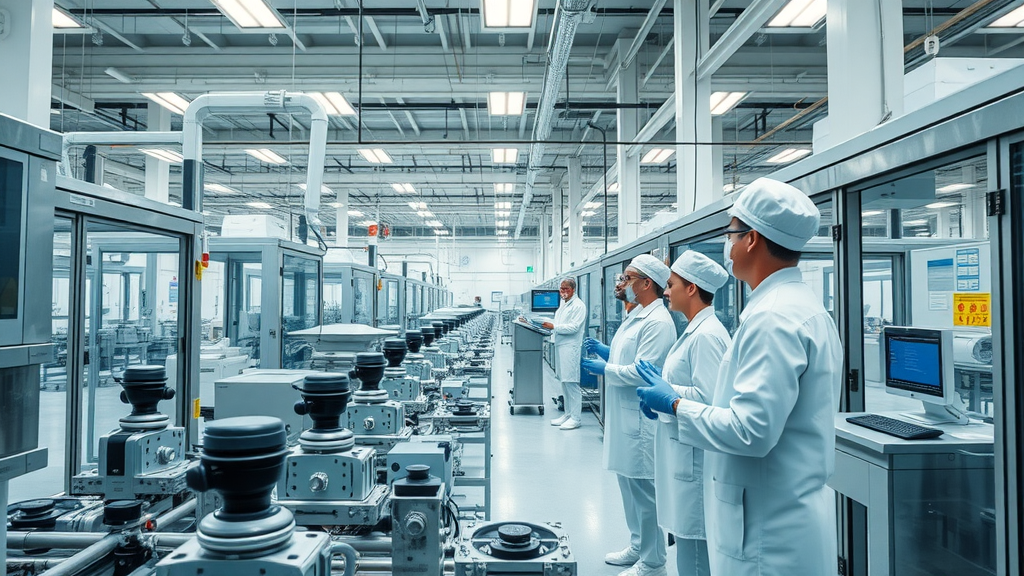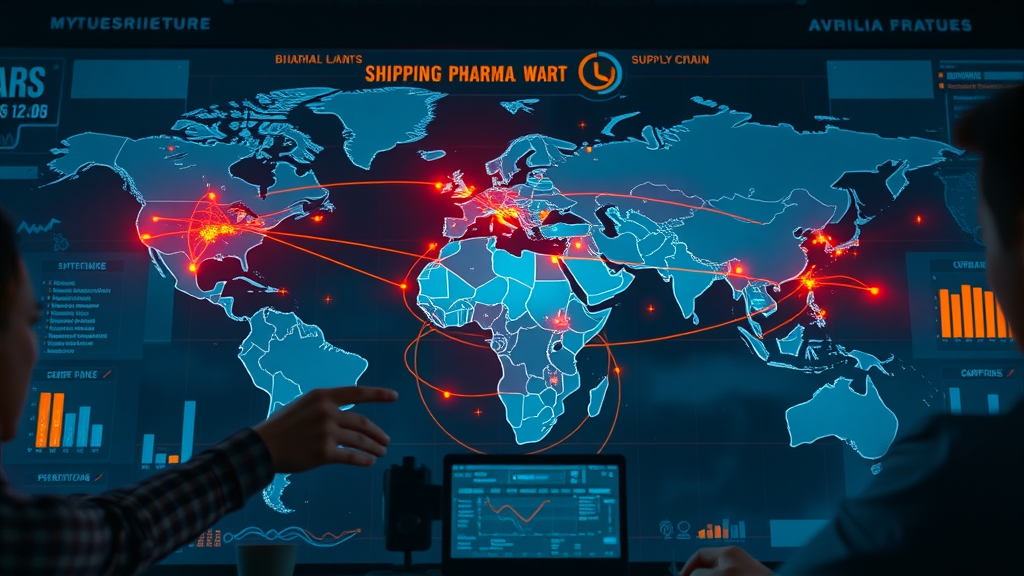Did you know that over 80% of active pharmaceutical ingredients (APIs) used in the United States are currently imported from overseas? This surprising reality exposes a profound risk: today’s pharmaceutical supply chains depend on global sources that are increasingly brittle, creating ever-greater fears around drug shortages and access to essential medicines. In this article, we’ll explore why drug manufacturing reshoring is rapidly gaining momentum as a solution not just to urgent supply chain woes but also to the future reliability of medicine in America.
Startling Trends: Why Drug Manufacturing Reshoring Dominates Today's Supply Chain Dialogue
“Recent data shows that over 80% of active pharmaceutical ingredients (APIs) used in the United States come from overseas—a risk that has come to define today’s supply chain vulnerabilities.”
In a world where the pharmaceutical supply chain is tested by global disruptions, the concept of drug manufacturing reshoring has leapt into mainstream conversation. It’s not just boardrooms and policymakers who are paying attention—public health experts, local manufacturers, and consumers are feeling the impacts of global drug shortages and clamoring for more secure access to medicines. Events ranging from import delays to national security issues have exposed how our reliance on drug manufacturers in China and India creates a domino effect of risk, especially when supply chains are interrupted. With stories emerging daily about drug shortages in American hospitals and neighborhood pharmacies, there’s a very real sense of urgency—and the discussion around bring production back home is only heating up.
Pushing drug manufacturing back to the United States isn't just about patriotism or economic nationalism. It’s a practical response to undeniable vulnerabilities. Pharmaceutical manufacturing reshoring is fundamentally about regaining control—reducing dependence on volatile global networks, minimizing the frequency of stockouts, and fueling chain resilience in the face of public health emergencies or international shocks. As the market and regulatory trends shift toward favoring domestic production, it becomes clear that the future of pharmaceutical supply and the fight against drug shortage are closely linked to where our medicines are actually made.

What You'll Learn
The core drivers behind reshoring drug manufacturing
How drug manufacturing reshoring can address persistent supply chain bottlenecks
Insights into the impact on global drug shortages and the pharmaceutical industry
Strategies for manufacturers adapting to the reshoring effort
Key takeaways for your future supply chain strategy
The Case for Drug Manufacturing Reshoring in a Disrupted Supply Chain
Global Drug Shortages and Pharmaceutical Supply Chain Challenges
Recent events have pushed global supply chains for pharmaceuticals to the brink, revealing a dangerous lack of redundancy and exposing patients to unprecedented drug shortages. The complexity that makes the pharmaceutical industry so effective—outsourcing, specialization, and just-in-time production—has become a double-edged sword. When Covid-19 ravaged logistics, and when geopolitical tensions ramped up between powerful players, the weaknesses in the U.S. pharmaceutical supply chain grew clearer than ever. Pharmacies and hospitals faced empty shelves, and the supply of essential generic drugs, antibiotics, and other critical medicines lagged dangerously behind demand. These shortages are particularly worrying for vulnerable populations and public health systems that rely on steady access.
With more than 80% of active pharmaceutical ingredients coming from a handful of overseas manufacturers—predominantly in China and India—every hiccup, regulation change, or export restriction reverberates instantly within U.S. borders. This interconnected, low-inventory approach may have driven costs down in the past, but today, it’s responsible for a domino effect of supply chain bottlenecks, delayed treatments, and, occasionally, real threats to public health. As pressure mounts, experts agree: reshoring effort is quickly becoming not just a business advantage, but a critical pillar of national security.

Pharmaceutical Manufacturing’s Vulnerability to International Disruptions
The COVID-19 pandemic served as a stress test, exposing just how sensitive the global supply chain for pharmaceuticals has become. Reliance on foreign facilities to create essential ingredients and finished drugs left countries scrambling when borders closed, transport routes were restricted, and overseas factories halted production due to local lockdowns. With active pharmaceutical ingredients often crossing international lines multiple times before reaching the end consumer, even minor delays balloon into major drug shortages.
But it isn’t just pandemics that threaten the system. Trade disputes between the United States, China, and India routinely disrupt pharmaceutical supply. Unexpected policy decisions—such as new tariffs, labor unrest, or environmental shutdowns—jeopardize every link in the supply chain. And for many American pharmaceutical companies, a sudden shortage of a single ingredient, or a glitch at an offshore manufacturing site, means entire product lines can be put at risk. These events catalyze a broader conversation about supply chain resilience and the real value of domestic manufacturing as a bulwark against unplanned events.
The Reshoring Effort: A Critical Analysis
It’s tempting to view the reshoring effort as a simple reversal of outsourcing, but the reality is far more nuanced. Successful drug manufacturing reshoring requires strategic investments in advanced technologies, regulatory compliance, and workforce readiness. Manufacturers are contending with higher domestic labor costs and greater oversight from bodies like the Food and Drug Administration—which can raise complexity in the short term. However, the potential rewards are significant: improved supply chain transparency, tighter quality controls, and swifter responses to sudden demand shifts.
Forward-thinking companies—both established players and new entrants—are leveraging this opportunity to build more robust, agile manufacturing networks within U.S. borders. From constructing state-of-the-art manufacturing facilities to forging new supply partnerships for raw materials, the industry is pivoting towards local solutions that prioritize security and chain resilience. While there are no quick fixes, the broad pharmaceutical reshoring movement is widely seen as a foundation for restoring public trust and catalyzing innovation in every corner of the pharmaceutical supply chain.

The Economic Argument: Domestic Manufacturing and Competitive Advantage
Domestic Manufacturing: Cost, Quality, and Security
At first glance, the case for domestic manufacturing in pharmaceuticals appears to clash with financial realities. Historically, labor costs and raw material prices have driven companies to offshore production, particularly to countries such as China and India. However, when factoring in the costs of supply disruptions, compliance headaches, and the billions lost during drug shortages, the equation becomes much more balanced.
Advanced manufacturing processes, automation, and data-driven quality assurance now offer U.S.-based factories a way to improve efficiency and offset higher wages. What’s more, domestic manufacturing arrangements offer competitive advantages in quality assurance and chain resilience—two metrics increasingly valued by the pharmaceutical industry and regulators alike. For manufacturers, investing in American production facilities also means better oversight, lower risk of substandard or counterfeit products, and an increased ability to secure national supplies of key medicines if crisis strikes. The benefits far outweigh legacy cost concerns when viewed through the lens of security, reliability, and long-term viability.

Case Study: How Eli Lilly is Reacting to Supply Chain Uncertainty
Eli Lilly, one of the world’s leading pharmaceutical companies, offers a powerful example of a proactive reshoring effort amid industry uncertainty. In direct response to global supply shocks and national concerns about drug shortages, Eli Lilly has funneled billions into expanding its U.S. manufacturing footprint. With advanced robotic assembly lines, real-time quality monitoring, and localized sourcing for essential pharmaceutical ingredients, the company protects itself from both unexpected border disruptions and foreign regulatory shifts.
By investing in new domestic production facilities and modernizing existing sites, Eli Lilly reduces dependence on distant suppliers and insulates its supply chain from international crises. Their approach is a direct acknowledgment of the importance of manufacturing capacity and agile supply networks—a necessity for the reliable delivery of vital drugs across the U.S. healthcare landscape. This case study illustrates how embracing a long-term supply chain resilience strategy, rather than continuing to chase the lowest upfront costs, provides tangible benefits for patients and pharmaceutical stakeholders alike.
Regulatory Shifts and Drug Manufacturing Reshoring Policy Incentives
Government Initiatives Supporting Pharmaceutical Manufacturing Reshoring
Recognizing the risks of overseas reliance, the U.S. government and policy-makers have begun to actively encourage drug manufacturing reshoring through targeted incentives and regulations. From direct funding for advanced manufacturing technologies to tax breaks and expedited approvals for domestic facilities, these policies aim to boost domestic production capacity and reduce foreign risk exposure. Recent legislative efforts have included grants for research and development, support for constructing new manufacturing sites, and financing programs designed to fortify the U.S. pharmaceutical supply chain.
Furthermore, U.S. regulatory agencies now increasingly collaborate with manufacturers to streamline approval processes and help mitigate some of the up-front costs associated with returning production to American soil. These proactive steps are a clear signal: reshoring effort is not only encouraged but is seen as a matter of national security and public health. The growing synergy between government and industry is a harbinger for faster, more reliable access to essential medicines throughout the country.

Tariffs, Trade Barriers, and Strategic Reshoring Efforts
International trade dynamics have a direct, powerful influence on the pharmaceutical supply chain. In recent years, tariffs and evolving trade agreements have increased the cost and complexity of importing drugs or raw materials from overseas. These policy changes not only strain already-tight budgets but also introduce new risks: sudden price hikes, delivery delays, and political uncertainty. For many pharmaceutical companies, these external pressures are a compelling reason to accelerate their reshoring strategies.
The Trump administration, for example, introduced a range of tariffs on Chinese pharmaceutical imports and encouraged manufacturers to explore alternatives closer to home. These “push” factors, combined with “pull” incentives like tax relief for domestic investment, are propelling a new wave of drug manufacturing reshoring efforts. Companies that act now, adapting to both the challenges and opportunities, stand to benefit from smoother supply chains, predictable pricing, and stronger ties to American healthcare markets.
Balancing Pharmaceutical Supply and Demand: Is Full Drug Manufacturing Reshoring Feasible?
The Technological and Logistical Hurdles of Drug Manufacturing Reshoring
While enthusiasm is strong, full-scale drug manufacturing reshoring still comes with daunting technological and logistical challenges. Establishing domestic manufacturing capacity requires more than new buildings; it demands investments in skilled talent, advanced automation, and sophisticated quality controls to match global standards. Building a robust supply chain often means cultivating new suppliers for raw materials, many of which are not currently produced in large volumes within the United States.
Challenges also include retrofitting or constructing state-of-the-art facilities, aligning them with strict Food and Drug Administration regulations, and ensuring that products meet rigorous safety and efficacy benchmarks. There are also questions about the viability of scaling up fast enough to meet surging demand, especially for high-volume generic drugs and specialty biologics. Despite these hurdles, companies equipped with the right strategy, resources, and partnerships are proving that rapid, smart adaptation is possible—and, most importantly, sustainable.

Workforce Readiness in the Pharmaceutical Industry
The promise of drug manufacturing reshoring will only be realized through a strong pipeline of domestic talent. Currently, the U.S. pharmaceutical industry faces a skills gap: to meet the demands of next-generation manufacturing, workers must be adept in technologies such as robotics, AI-driven quality control, and real-time data analytics. Industry leaders are investing in education initiatives, partnering with universities, and offering in-house upskilling to ensure that the workforce is prepared for this new chapter.
By prioritizing workforce readiness, pharmaceutical companies increase the likelihood that domestic manufacturing can be both efficient and innovative. These proactive steps not only support economic growth and job creation, but also set a global standard for quality and operational excellence in pharmaceutical supply chains. This long-term vision of American pharmaceutical manufacturing hinges on people just as much as it does on policy and technology.
The Impact of Drug Manufacturing Reshoring on Drug Shortages
Alleviating Drug Shortages through a Stronger Domestic Supply Chain
For patients and providers alike, the most compelling benefit of drug manufacturing reshoring is its potential to alleviate drug shortages. By moving supply chain nodes closer to the point of need, manufacturers dramatically reduce the risk of interruptions—whether from natural disasters, shipping delays, or overseas policy changes. A resilient domestic supply chain means more consistent inventory of vital medicines, fewer emergency rationing scenarios, and stronger confidence from healthcare professionals.
Several companies, including innovative generic drug manufacturers, have already begun to see tangible improvements in reliability and flexibility from investing in U.S.-based production. This shift not only minimizes supply shocks but also positions organizations to quickly meet surges in demand—whether driven by pandemics or localized outbreaks. Ultimately, drug manufacturing reshoring is rapidly becoming the most promising route toward a safer, more dependable pharmaceutical supply in an unpredictable world.

Industry Voices: Expert Opinions on Pharmaceutical Manufacturing Reshoring
“Reshoring isn’t a quick fix, but it’s a necessary long-term play for the resilience of the pharmaceutical industry.” – Industry Analyst
There is broad consensus among industry experts that drug manufacturing reshoring will shape the next decade of pharmaceutical supply. Many analysts believe it signals a transition toward a more sustainable, patient-centric model. While a few caution that the road ahead will have its share of growing pains, most industry voices agree: the momentum is irreversible. Community leaders and chief executives alike recognize that building a more reliable pipeline requires partnership, innovation, and steady reform—key ingredients that are now driving policy, investment, and talent strategies throughout the U.S. pharmaceutical landscape.
Additionally, as public concern over drug shortages climbs, manufacturers and policy makers alike are taking action, catalyzing long-overdue conversations about public health and national security. The shift towards domestic production is no longer simply an economic play; it’s a cornerstone of both public trust and industry viability in the 21st century.
Competitive Analysis: How Leading Pharmaceutical Companies Approach Drug Manufacturing Reshoring
Strategies and Reshoring Efforts from the Pharmaceutical Industry
Leading pharmaceutical companies are mapping out a variety of innovation-driven approaches to manage drug manufacturing reshoring. Some are leveraging public-private partnerships to support domestic production of active pharmaceutical ingredients, while others are forming innovative joint ventures to share research, risk, and infrastructure costs. There’s a clear focus on building manufacturing capacity that enables flexible, small-batch runs for critical drugs while also preserving the ability to scale for wider demand.
The growing popularity of digital supply chain monitoring, real-time analytics, and predictive demand planning means these competitive strategies are robust—capable of weathering the unpredictable storms of global trade, logistics, and regulation. As the pharmaceutical industry continues its transformational reshoring effort, companies with advanced, agile supply networks stand to reap major early-mover advantages in security, reliability, and patient outcomes.
Eli Lilly’s Supply Chain Reshoring Blueprint
Eli Lilly’s blueprint for domestic drug manufacturing reshoring is instructive for industry peers. Their multi-phase plan integrates infrastructure investment, strategic supplier development, and the deployment of cutting-edge automation at U.S.-based facilities. They also emphasize local partnerships to source high-quality raw materials—minimizing risk, slashing lead times, and enabling quicker regulatory response to market needs.
Their commitment to chain resilience is evident in the way they’re rethinking everything from logistics to workforce training. The company’s highly visible U.S. expansion is a masterclass in aligning resource allocation, technology, and compliance—all with the single aim of safeguarding drug supply for the American public. This blueprint is quickly becoming a benchmark for others racing to strengthen the domestic pharmaceutical supply chain.

Tables: Global Drug Manufacturing Trends and Reshoring Success Stories
Comparison of Overseas vs. Domestic Drug Manufacturing Costs, Lead Times, and Resilience |
||
Overseas Manufacturing |
Domestic Manufacturing (U.S.) |
|
|---|---|---|
Average Cost per Batch |
Lower (due to labor costs) |
Higher, but offset by reduced disruption |
Lead Time |
6-12 weeks (with risk of delay) |
2-4 weeks (with greater reliability) |
Supply Chain Disruption Risk |
High (political, logistical, quality issues) |
Low to Moderate (subject to local challenges) |
Regulatory Oversight |
Variable; less direct control |
Consistent, rigorous (FDA and state agencies) |
Timeline of Major Pharmaceutical Industry Reshoring Efforts |
||
Year |
Company |
Key Reshoring Milestone |
|---|---|---|
2020 |
Eli Lilly |
Began construction of major U.S. manufacturing facility |
2021 |
Pfizer |
Invested over $500M in advanced U.S. vaccine production plant |
2022 |
Amgen |
Unveiled US-based advanced API facility utilizing robotics and AI |
2023 |
Novartis |
Announced a multi-state reshoring strategy focused on supply chain agility |
Key Considerations for Manufacturing Leaders: Moving Forward with Drug Manufacturing Reshoring
Supply chain transparency
Regulatory compliance
Investing in domestic capabilities
Monitoring pharmaceutical supply volatility
Maintaining agility amid global trade uncertainty
People Also Ask
How does drug manufacturing reshoring impact pharmaceutical supply chains?
Drug manufacturing reshoring strengthens pharmaceutical supply chains by reducing dependency on foreign suppliers and improving chain resilience. By relocating production facilities to the United States, manufacturers can respond quickly to changes in demand and unforeseen disruptions, keeping medical supply consistent for patients and healthcare providers. The increased visibility and proximity of supply also boost compliance and quality assurance—two strengths that further shield pharmaceutical companies from drug shortages.
What are the primary challenges facing drug manufacturing reshoring?
The primary challenges include higher labor costs, sourcing of raw materials domestically, scaling up manufacturing capacity quickly, and ensuring workforce readiness for new technologies. Regulatory requirements in the U.S. can also add time and cost to the reshoring process. However, many companies are overcoming these hurdles via automation, robust investment in domestic infrastructure, and strategic partnerships with local ingredient suppliers, making the move increasingly feasible.
Can drug manufacturing reshoring solve the issue of drug shortages?
Yes, reshoring drug manufacturing can significantly reduce the risk and frequency of drug shortages by building a more resilient, responsive pharmaceutical supply chain. By producing active pharmaceutical ingredients and finished products closer to the point of need, companies are less vulnerable to global disruptions and can more effectively manage inventory, preventing critical stockouts. While not a panacea, it is one of the most effective strategies for alleviating supply chain vulnerabilities in the pharmaceutical industry.
FAQs about Drug Manufacturing Reshoring
What is drug manufacturing reshoring?
Drug manufacturing reshoring is the process of moving the production of pharmaceuticals and their ingredients from international locations back to domestic sites, primarily within the United States, to strengthen supply chain security and reliability.How does reshoring improve supply chain resilience?
Reshoring minimizes reliance on foreign suppliers, reduces exposure to global disruptions, and places more control in the hands of domestic manufacturers—ultimately making supply chains more adaptable and efficient.Who are the key players driving the reshoring effort in the pharmaceutical industry?
Major pharmaceutical companies like Eli Lilly, Pfizer, Amgen, and Novartis, along with government agencies and policy-makers, are at the forefront of the U.S. drug manufacturing reshoring movement.

Key Takeaways: Ensuring Supply Chain Resilience with Drug Manufacturing Reshoring
Drug manufacturing reshoring is reshaping supply chain strategy for the pharmaceutical industry.
Domestic manufacturing can reduce risk and bolster the pharmaceutical supply.
Regulatory support and industry innovation are catalysts for sustainable reshoring efforts.
Conclusion: Why Drug Manufacturing Reshoring Is More Essential Than Ever
“The future of pharmaceutical manufacturing lies in strategic reshoring—promising both greater security and supply chain agility.”
Drug manufacturing reshoring isn’t just a trend—it’s a strategic imperative for a safer, more reliable, and innovative pharmaceutical future.
Watch an in-depth, expert roundtable discuss the real-world impact of drug manufacturing reshoring on resilience, innovation, and competitive positioning in the pharmaceutical supply chain.
Explore success stories, lessons learned, and best practices in drug manufacturing reshoring initiatives with this real-world video case study.
Act Now: Stay Ahead in the New Era of Drug Manufacturing Reshoring
Manufacturer don't miss out! Stay informed on global trade shifts-tariffs, reshoring, and supply chain updates could reshape your strategy. Subscribe to Global Trade News for Latest updates. Call 203-271-7991 today.
 Add Row
Add Row  Add
Add 




Write A Comment